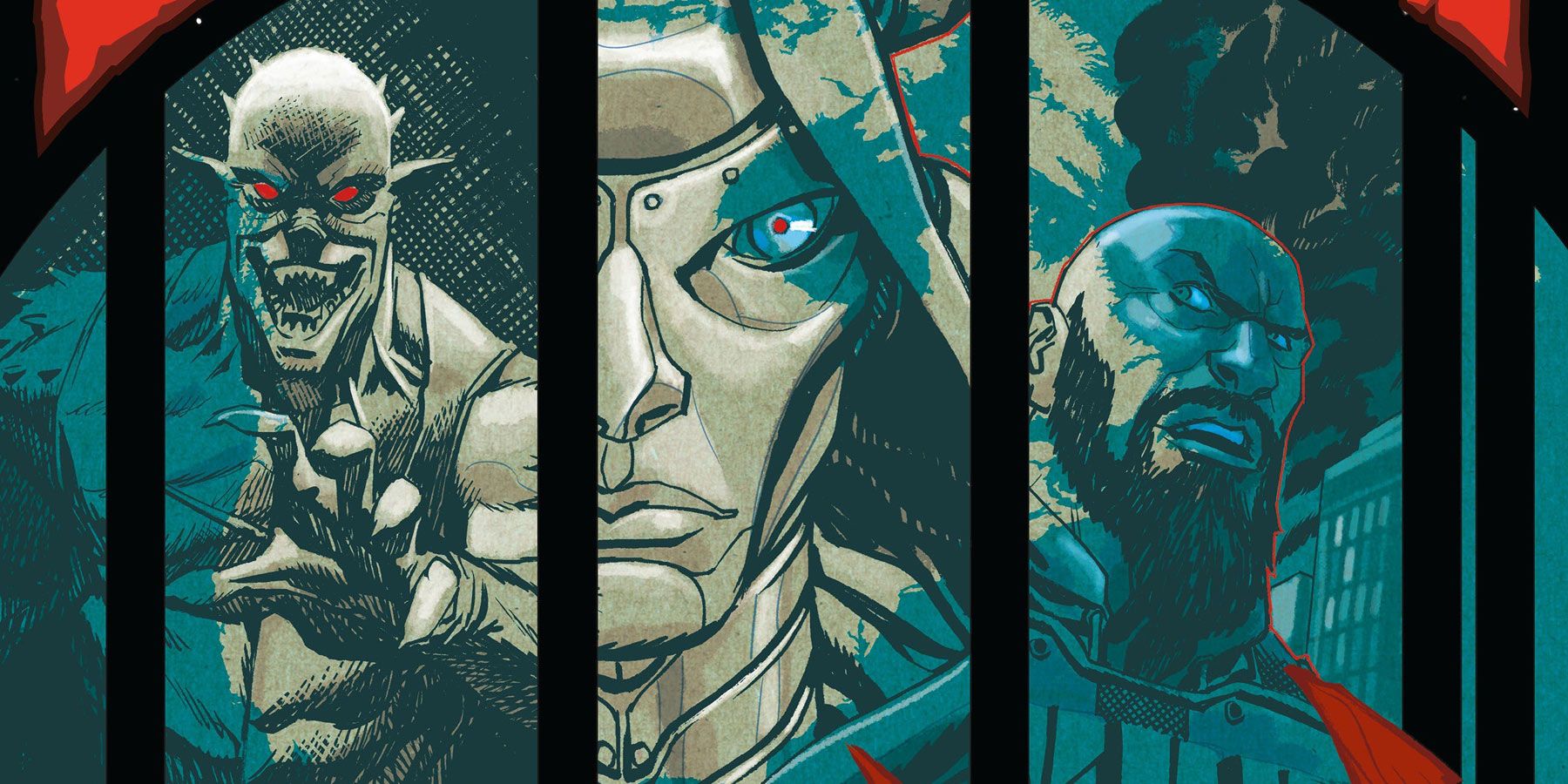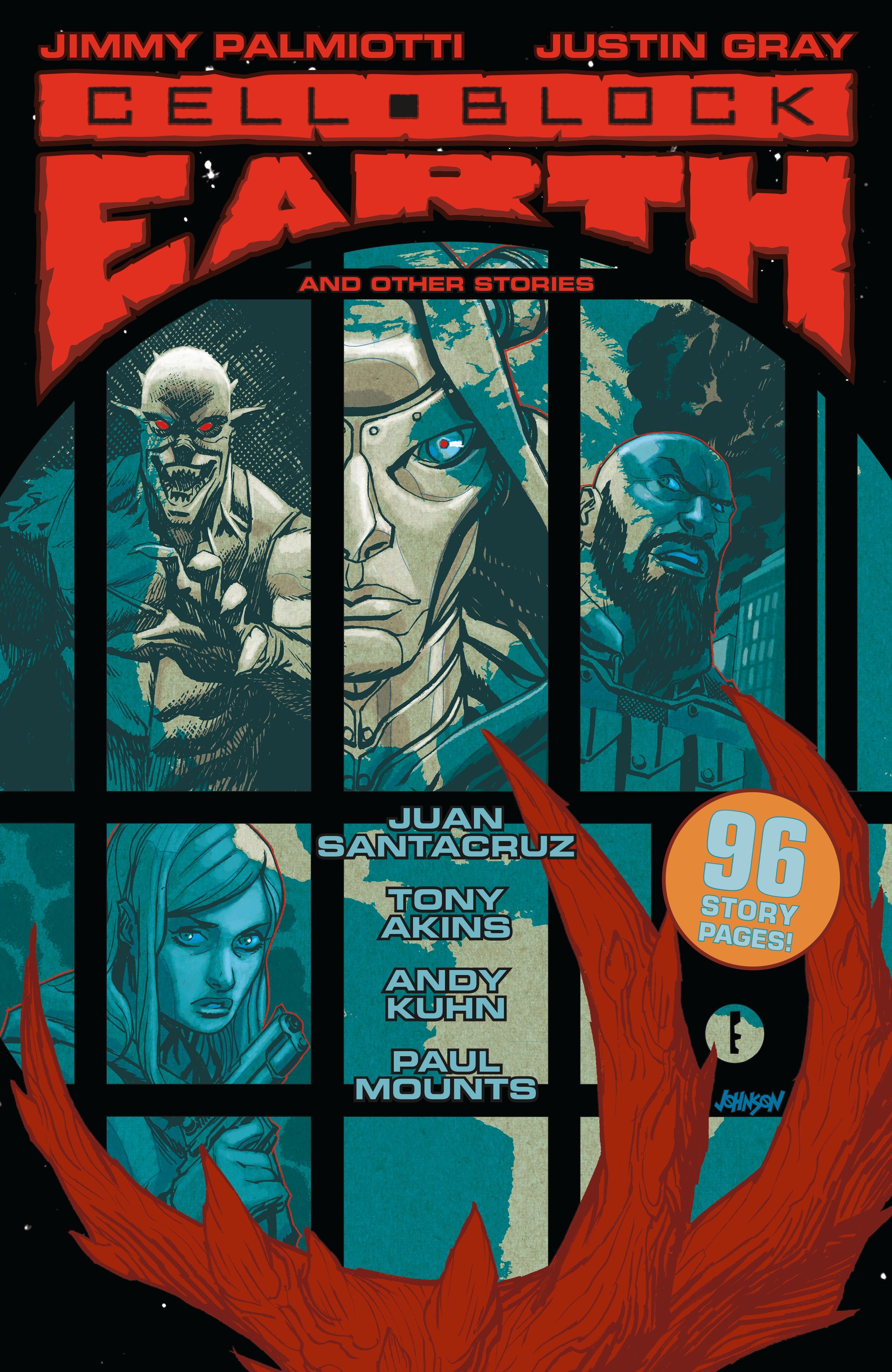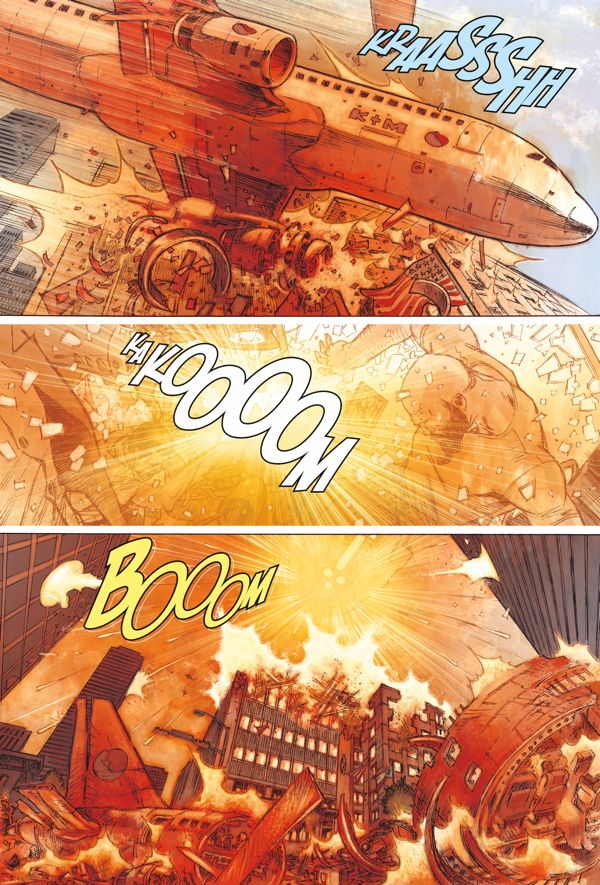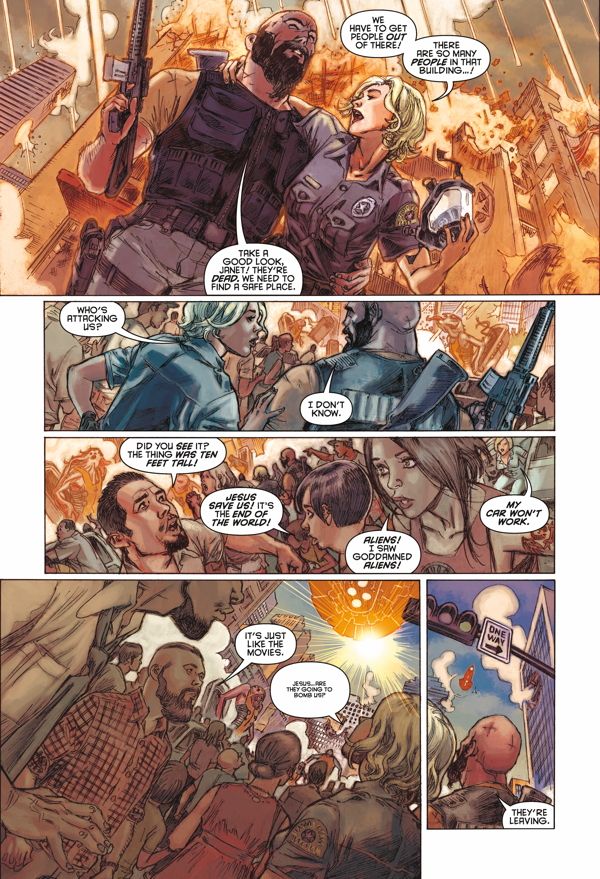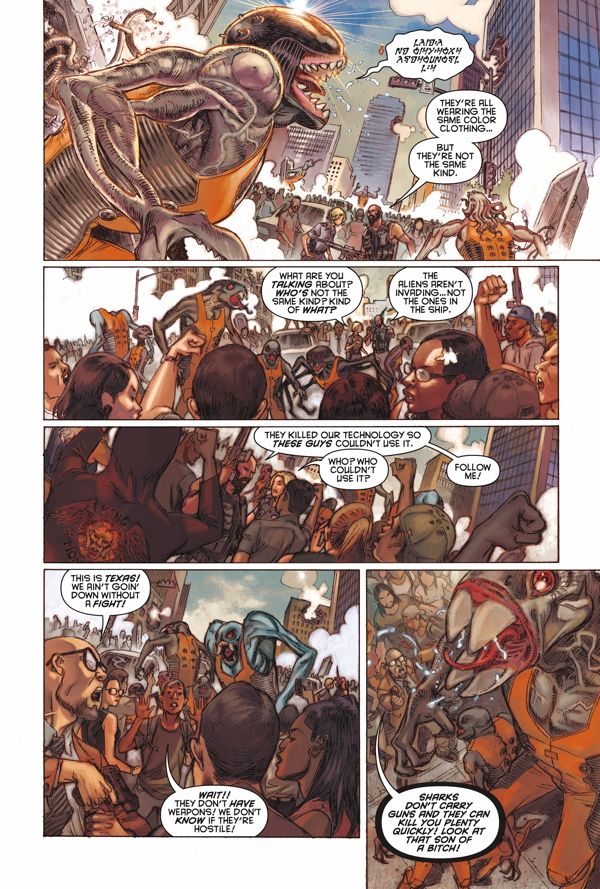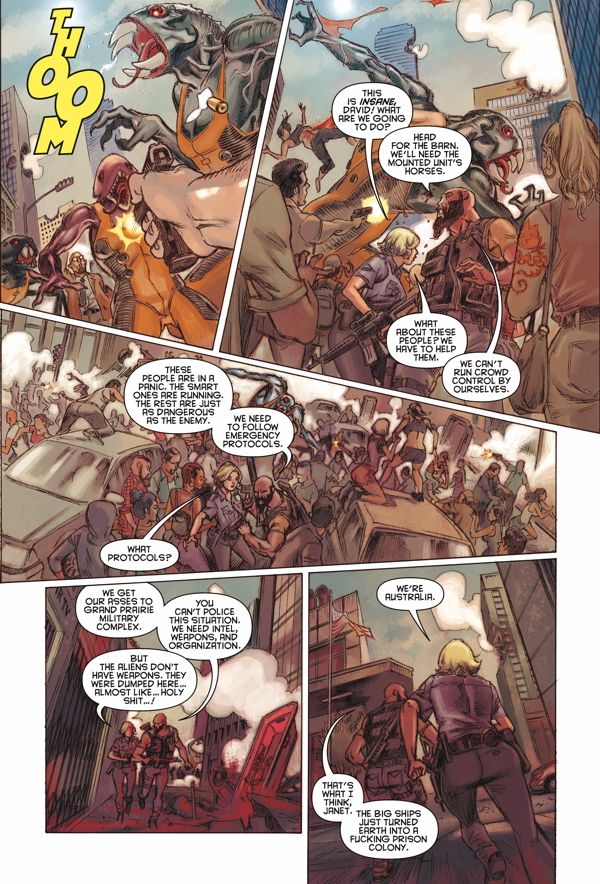Jimmy Palmiotti and Justin Gray are known to many comics fans for writing superheroes like Power Girl or Hawkman, or for their lengthy runs on Jonah Hex and All Star Western. But the two have also spent years working on a long list of comics in other genres for different publishers. They’ve published a number of books through PaperFilms including Sex and Violence and Retrovirus, and they work with Adaptative Studios where they’ve written and edited books such as Abbadon and Hype.
Late last month, Dark Horse Comics released Cell Block Earth and Other Stories. The book consists of two stories that appeared in Dark Horse Presents -- "The Deep Sea" and "Wrestling with Demons " -- along with the titular all-new story. Palmiotti also has recently launched a a href="https://www.kickstarter.com/projects/1397702842/killing-time-in-america-a-hardcover-adult-graphic" target="_blank">Kickstarter campign for a new hardcover graphic novel, Killing Time in America.
RELATED: Palmiotti and Gray Dive Into The Deep Sea
CBR talked with the duo about Cell Block Earth and Other Stories, writing short comics and self-contained stories, and what they’re working on now.
CBR: So what is Cell Block Earth and Other Stories?
Jimmy Palmiotti: The "Cell Block Earth" story is a brand-new 24-page story about aliens dumping their criminals on earth and leaving, featuring the amazing art of Juan Santacruz, my artist on Painkiller Jane and The Resistance from a while back. The second story, "The Deep Sea," is about a bunch of explorers lost at sea that are found 40 plus years later, and haven’t aged a day. That features the art of Tony Akins and Paul Mounts.
Justin Gray: All three stories are rooted in pulp fiction genres ranging from deep sea and kaiju to demons and monster and finally an alien invasion of sorts. In "Wrestling with Demons," an MMA fighter and his daughter are traveling to his first big fight in Las Vegas, but when they stop in an old ghost town his daughter is kidnapped by supernatural creatures. That features beautiful and moody art by Andy Kuhn and John Rauch. The book has 96 pages of story.
How did you two end up writing comics for Dark Horse Presents?
Palmiotti: We wrote the two older stories a few years back for DHP and the third recently. We were asked by the guys there to pitch some new ideas and we went out trying to cover something different than just superheroes. We chose these three particular genres because they each have something fun to them.
You were writing these stories in eight-page chapters -- how did that shape these stories, or how you wrote?
Palmiotti: We had to get to the core of the stories a lot quicker than usual and not spend a ton of time developing small details. Justin and I have a lot of experience how to do this after writing done-in-one Jonah Hex books for 7 years.
Gray: Exactly, they had to be lean, sharp and very compact, but that was a great opportunity to focus squarely on packing as much punch into each tale as we could. Creatively, it was very challenging and rewarding because when you tell short stories they need to grab the reader immediately, and never let go.
I was going to say, the two of you wrote Jonah Hex for years which were mostly self-contained stories, which is something we don't see in comics, and short stories, or eight-page chapters, aren't something that we see in comics much anymore, either.
Palmiotti: I think it’s coming back. We did that a lot with Harley Quinn as well. It goes back to classic comic book storytelling, where the companies weren’t dragging out stories to get you to buy a ton of books. I love the idea that someone can read one book and get an entire story.
Gray: It is funny that you mention that, because it is exactly the kind of thing I think we need more of. I’m currently developing a new supernatural western called Billy The Kit, that works with the model of short contained story arcs in much the same way as Jonah Hex. We have so many serialized forms of entertainment that I think have become watered down by being so drawn out. They also reach a point where the only thing holding them together is what came before and a sense of nostalgia.
Were you two interested in writing more stories with these characters, picking up plot threads and doing more? Or did you also intend each as a one-time thing?
Palmiotti: Given the opportunity and if this book does well, we both would like to finish up "Deep Sea" and do more "Cell Block Earth." As far as "Wrestling with Demons," I feel we told the whole story, but you never know.
Gray: We tend to create these expansive worlds and each of these stories have room to grow and more stories to tell, but I think that’s the fun of creating things. "Cell Block Earth" and "Deep Sea" are both very cinematic.
You guys have written short comics elsewhere, for some of the books you did through Kickstarter. What do you like about them, and do you wish there were more outlets and more places to make them and read them in print?
Palmiotti: I really do, but it’s not always what readers want. When we published Sex and Violence – which is still available at paperfilms.com – we loved the idea of done in one type books and we have more Kickstarter’s coming where we explore this format, such as the one I have out [now] called Killing Time in America, it’s a done-in-one hardcover graphic novel. I just think things like that are always a hard pitch unless you do them as a graphic novel. The monthly floppies of new ideas are getting harder and harder to sell unless you have a big-name talent attached.
Gray: Absolutely, Kickstarter gives creators an opportunity to craft material for ourselves and for those stories to find an audience thanks to really amazing and supportive people in the comic community. I go over this all the time if someone asks me why I think more people should use Kickstarter and self-publish with all the tools now available to them. Large publishers are beholden to moving massive volume. The average mainstream superhero comic is cancelled at roughly 10K units. If you move 10K units a month as an indie comic you’re making 4X what you’d get paid to write that cancelled superhero comic. Yes, you’re working more and you have to pay people, but in the end you’re generating more revenue for yourself.
So, yeah, I wish there were more outlets, I wish there were clearer lines of demarcation on mass market bookstore shelves. Graphic novels at chain stores are shelved in such a way that discourages market growth. It’s disgusting because there’s Manga in one area and there’s everything else smashed together in a big shiny mess, including pop culture material like handbooks, Doctor Who memorabilia, movie tie-ins, and that completely discourages anyone not familiar with navigating that content.
Page 2: [valnet-url-page page=2 paginated=0 text='Focusing outside the superhero genre, next projects for Palmiotti and Gray']
To go in the opposite direction from short comics, you two have also been working at Adaptive Studios on different projects there. Do you want to say a little about what you've been doing, and the kinds of projects you've been working on?
Palmiotti: We are constantly trying new things, and working with our partners at Adaptive has been an interesting experience for us mainly because they put out a great product and have a bookstore presence, which is not so easy to get. My goal is to build my name as a brand so it becomes easier to get placement of the experimental work I want to do. Superheroes are easy, but genre material is a uphill climb all the way. It's why the Kickstarters are so important to me, and partnering with others that can get the books out to the public in different ways is important.
Gray: Adaptive has great leadership and great people who are forward-thinking in applying different models. In response to my previous comment about shelving, Adaptive has the strategic acumen to see to it that their books are placed in an endcap. They also have an understanding of the creative process and that you pair the right people with the right project. They also look at the quality of concept over chasing trends or trying to skim off an already small market.
RELATED: Conner, Palmiotti Talk The Jetsons, Harley Quinn & Paul Dini
You two also wrote "Rubber Guns" for DHP, which isn't in this collection. Is there any chance we'll see more in DHP from you? And another book of short comics stories?
Palmiotti: I am keeping an eye on how this book is sold and received and weighing my options to what is available to me out there. I am in a place where I have little interest in writing other people’s characters, and if I am going to spend time on something, I am going to want to own it outright. That may change after a while, but for now, I am building up my library of properties and characters, striking while the iron is hot.
Gray: Going off what Jimmy said, I’m open to anything, but I’ve been focusing on writing novels and developing comic projects that I’m excited about and personally invested in. I spent a fair amount of time looking at commercial writing from the perspective of what other people want and then trying to put my spin on that. In retrospect that was both a mistake and a poor decision creatively, because for a period of time it stopped me from growing.
I think that speaks to what Jimmy says about writing other people’s characters, because a lot of time the term “creator” is loosely thrown around. I didn’t create Superman so if I write a Superman story I am more of a curator, I’m carrying the torch passed down from someone else and I’ll hand it off when my time is up. To that end, I’m also free to explore different ideas and genres. I can write material that is for adults and I can write a book like The Adventures of Penelope Hawk, which is for middle-grade readers. Traditional publishing is glacial, self-publishing I can put out as many books as I can write. That’s what I’ve been planning and developing for a year now.
You're always busy with a lot of projects. Do you want to mention anything you're working on right now or is coming out soon?
Palmiotti: I have the last issue of Jetsons coming out, then the Killing Time in America Kickstarter going on now and after that Amanda Conner and I have a few books we are going to do, including a Painkiller Jane series published by Paperfilms.
Gray: I’m hard at work writing and developing Billy the Kit, which is a supernatural western talking animal comic, drawn by Barry McClain Jr. It is equal parts Jonah Hex and Bugs Bunny with a little Jack Kirby thrown in for flavor. The sole survivor of a massacre that claimed the lives of his entire family sets out to hunt down the person responsible -- an ancient tornado god named Chulyen. The idea of a foul-mouthed gunslinging rabbit fighting Kirby Gods is just too much fun for me to ignore. Hopefully we will be rolling that book out monthly starting this fall.
I’m also writing a trilogy of middle-grade fantasy novels called The Chroma Chronicles, an all-ages graphic novel called Arthur and the Hook of Destiny about a cursed boy on an island in the middle of the ocean, a science fiction novel called The Orbit, and Jimmy and I are collaborating again on Sex & Violence 3.
Cell Block Earth and Other Stories is available now from Dark Horse Comics.

